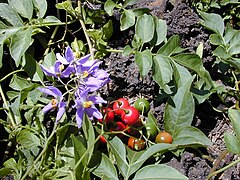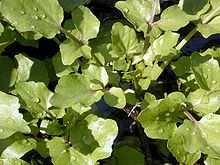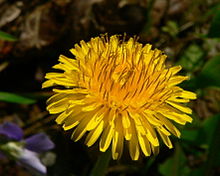CAN WE USE THEM EASTHETICALLY IN THE LANDSCAPE?
DO THEY HAVE MEDICINAL USES?
-
Although errantly assumed to compete with neighboring plants for food and moisture, some "weeds" provide the soil with nutrients, either directly or indirectly.For example, legumes, such as white clover, add nitrogen to the soil through the process of nitrogen fixation, where bacteria symbiotically living in their roots extract nitrogen from the atmosphere, making it accessible in the soil for its host, and any nearby plants.Others use deep tap roots to bring up nutrients and moisture from beyond the range of normal plants, so that the soil improves in quality over generations of that plant's presence.Weeds with strong, widespread roots also introduce organic matter to the earth in the form of those roots, turning hard, dense clay dirt into richer, more fertile soil.In fact, some common plants like tomatoes and corn will "piggyback" on nearby weeds, allowing their relatively weak root systems to go deeper than they could have alone.THE FOLLOWING PICTURES OF WEEDS ARE LISTED ON THE BENEFICIAL WEED CHART BELOW:
Euphorbia lathyris












Clover
Cocklebur

Crow Garlic

Dandelion
Goldenrod

Ground Ivy

Horsenettle

Milkweed

Nasturtium

Nettle

Purslane

Queen Anne Lace

Wild Mustard

Wild Rose

Wild Vetch
| Beneficial Weed Chart | |||||||||
|---|---|---|---|---|---|---|---|---|---|
| Common name | Scientific name | Companion plant for | Attracts/hosts | Repels | Traps | Edibility | Medicinal | Avoid | Comments |
| Bashful Mimosa | Mimosa pudica | ground cover for tomatoes, peppers | predatory beetles | Its extract immobilizes the filariform larvae of Strongyloides stercoralis in less than one hour.[1] In contemporary medicine, Mimosa pudica is being investigated for its potential to yield novel chemotherapeutic compounds. It contains an alkaloid calledmimosine, which has been found to have potent antiproliferative and apoptotic effects.[2] | Used as a natural ground cover in agriculture | ||||
| Caper Spurge | Euphorbia lathyris | Moles | Used in folk medicine as an antiseptic and purgative | Many domesticated animals can eat it, although it's poisonous to humans. Beneficial weeds can accomplish a number of roles in the garden or yard, including fertilizing the soil, increasing moisture, acting as shelter or living mulch, repelling pests, attracting beneficial insects, or serving as food or other resources for human beings. | |||||
| Clover | Trifolium | Brassica (cabbage and cousins like broccoli and cauliflower), corn, cucurbits (cucumber, squash, melons, gourds) -- Along with fertilizing the soil, this plant provides a humid microclimate that benefits many plants by stabilizing their moisture | Rabbits | This legume is a high-protein source of food, but generally only eaten in survival situations | Nightshades(tomato, pepper, eggplants) | This legume hosts nitrogen-fixing bacteria in its roots, and therefore fertilizes the soil for neighboring plants. It is also used as a fallow plant by some farmers, and is a very popular fodder plant. | |||
| Cocklebur | Xanthium | Grasses and grains | Army worms | Is used in Chinese medicine | Poisonous to some lifestock | Also used for yellow dye | |||
| Common name | Scientific name | Companion plant for | Attracts/hosts | Repels | Traps | Edibility | Medicinal | Avoid | Comments |
| Crow garlic | Allium vineale | fruit trees, nightshades (tomatoes, peppers, potatoes, etc.), brassicas (cabbage, broccoli, kohlrabi, etc.) carrots | slugs, aphids,carrot fly, cabbage worms[3] | Can be used like conventional chives | 3-mercapto-2-methylpentan-1-ol in onion was found to have an antioxidant potent that inhibitsperoxynitrite induced diseases.[4] | beans, peas, parsley | This is a wild cousin of onions and garlic | ||
| Dandelion | Taraxacum | Various grains, tomato plants | Honeybees | Armyworms | In season, leaves and flowers are edible | Used as a diuretic in herbal medicine | Tap root breaks up hardened soil and brings up nutrients from deep down, benefiting plants with weaker or shallower roots without competing with them. | ||
| Goldenrod | Solidago | Pear trees, Black Locust Tree, Sugar Maple | Predatory wasps | VariousLepidopteralarvae | Numerous medicinal uses | Contains latex, the automobile given to Thomas Edison by Henry Ford had tires made from goldenrod latex | |||
| Ground Ivy | Glechoma hederacea | Tomatoes, peppers, cucumbers and relatives (squash, melons), broccoli, brussels sprouts, cauliflower | cabbage worms, cucumber worms and beetles, tomato horn worms, others | Can be used in herb tea, high in vitamin C | Used in the traditional medicine of Europe going back thousands of years. Inflammation of the eyes, tinnitus, a diuretic, astringent, tonic and gentle stimulant. See here for more. | This wild mint makes a good ground cover companion plant, creating a humid microclimate, covering up nearby plant scents, and distracting pests from companion crops. | |||
| Common name | Scientific name | Companion plant for | Attracts/hosts | Repels | Traps | Edibility | Medicinal | Avoid | Comments |
| Horsenettle | Solanum carolinense | Predatory beetles | The berries of this fruit may be edible when cooked | Ripe fruit, when cooked, is used by herbalists as a diuretic and sedative | |||||
| Milkweed | Asclepias | Corn, basil, potatoes | Predatory wasps | Wireworms | Folk remedy for warts, sap reduces poison ivy symptoms | Can be used as a more effective insulator than goose down. Emits a chemical that breaks up hard soil, allowing nearby plants to develop healthier root systems. Basil repels some insects that attack milkweed. | |||
| Nasturtium | Tropaeolum | Most vegetables, especially brassica (cabbage, broccoli, et al.), cucurbits (cucumbers, melons, squash) and solanum (tomatoes, potatoes, peppers, etc.) | Predatory wasps | Squash bugs,cucumber beetles,striped pumpkin beetles,woolly aphids | trap cropfor caterpillars and black aphids | All parts of this plant are edible, flowers and leaves make brilliant salad decoration | Considered one of the "magic bullet" companion plants, benefiting almost any crops around it in some way, and not known to hurt any | ||
| Nettle | Urtica dioica | broccoli, tomato [1], Valarian, mint, fennel | bees | Despite its "sting", young plant parts are edible, as is much of the plant when blanched or otherwise prepared. Also makes a nutritious herb tea | One of the most-used plants in herbal medicine, with a long list of benefits[2] | Also once grown as a crop for its fiber. Its juice was once used in the place of rennet in cheese-making. It was also a source of "green" for dye. It can still be used as a high-protein additive in animal feed, once dried. | |||
| Common name | Scientific name | Companion plant for | Attracts/hosts | Repels | Traps | Edibility | Medicinal | Avoid | Comments |
| Purslane | Portulaca oleracea | corn, solanums like tomatoes and peppers | Purslane is eaten throughout much of Europe and Mexico. It contains more Omega-3 fatty acids than any other leafy vegetable plant. It can be eaten in salad, stir-fried, or cooked like spinach. berries can be eaten like capers | In Traditional Chinese Medicine, it is used to treat infections or bleeding of the genito-urinary tract as well as dysentery. It may also be applied topically to relieve sores and insect or snake bites on the skin. | Dill, parsnip, radish | Breaks up hard soil and hardpan, brings nutrients and water up from deeper than crops can reach, provides healthy ground cover, stabilizing soil moisture | |||
| Queen Anne's Lace | Daucus carota | Nightshades (especially tomatoes), alliums (onions, chives), lettuce | predatory wasps and flies | Young roots are edible | Some recent scientific support for its historic use as a herbal contraceptive | Dill, parsnip, radish | Do not confuse with its poisonous cousin, water hemlock | ||
| Wild Mustard | Brassicaceae | Grape vine [3], radish, non-mustard brassica, including cabbage, cauliflower, broccoli | Ladybugs | Traps various brassica pests, including aphids | Seeds and leaves are edible | beets | Domesticated mustard is a hybrid of three different species of wild mustard, all of which are still used in some places for food. This is known as the Triangle of U. | ||
| Wild Rose | Rosa | Strawberries, grapes, roses | Rodents and deer | Traps Japanese beetles | Rose hips can be used in herb tea | Same medicinal benefits as domesticated rose | This includes the feralmultiflora rose, brought to the US [4] both for use as root stock for domesticated roses, and as a "natural fence" for lifestock. In the mid 20th century miles of multiflora rose hedge were planted in sequence. | ||
| Common name | Scientific name | Companion plant for | Attracts/hosts | Repels | Traps | Edibility | Medicinal | Avoid | Comments |
| Wild Vetch | Vicia americana | Pepper and tomato plants, brassica (cabbage, mustard, broccoli), other plants needing high nitrogen | Provides ground cover for predatory beetles | This legume fixes nitrogen, allow it to grow in a tomato garden only until time to plant, as ground cover. But can be left growing among brassica for additional nitrogen and microclimate | |||||










